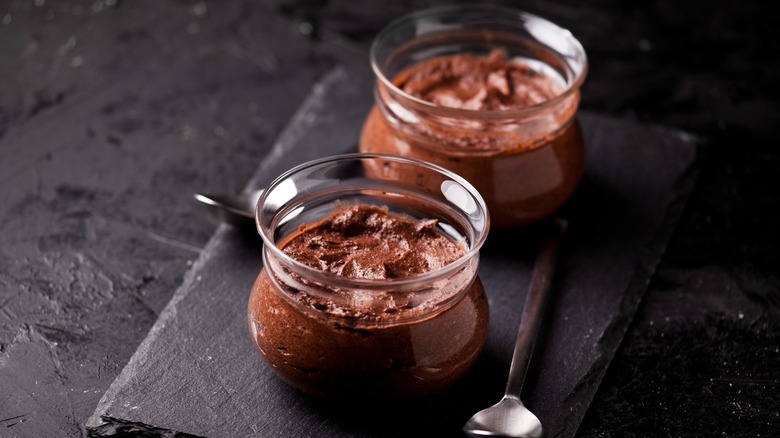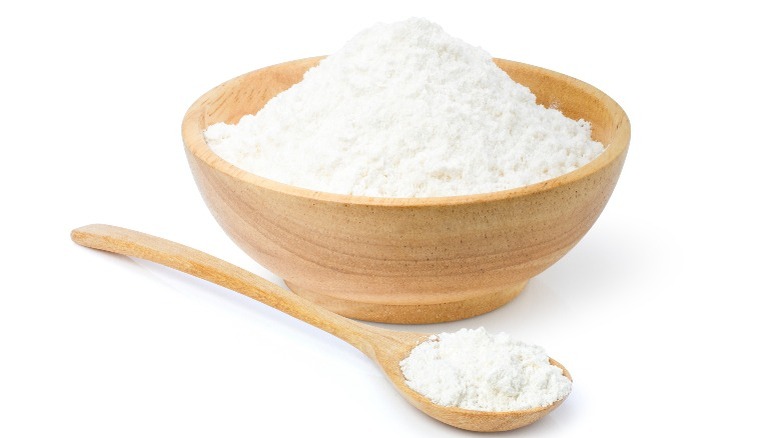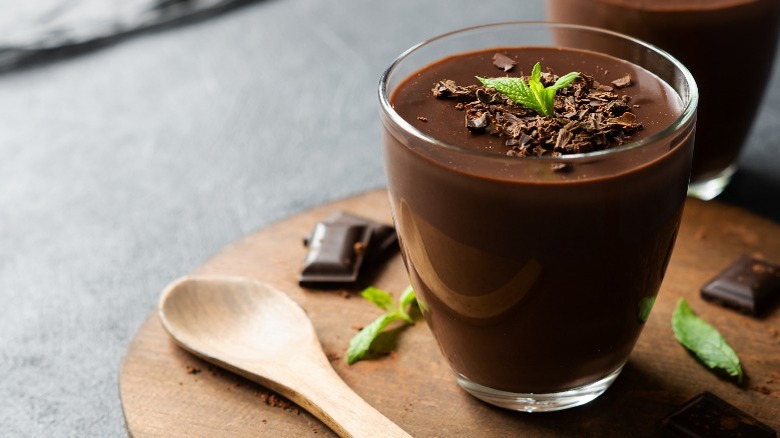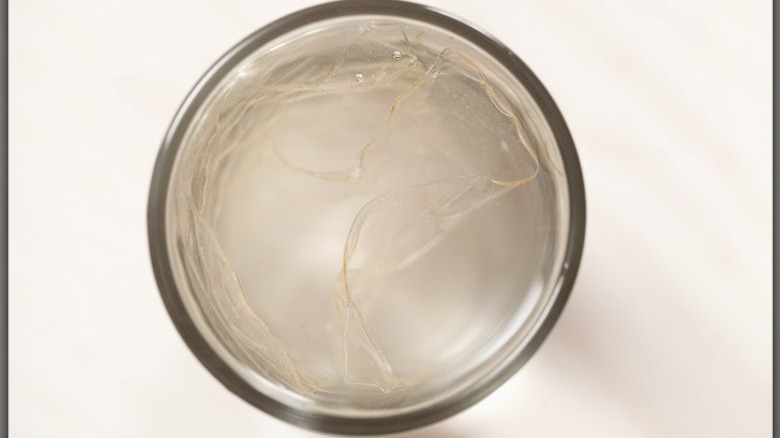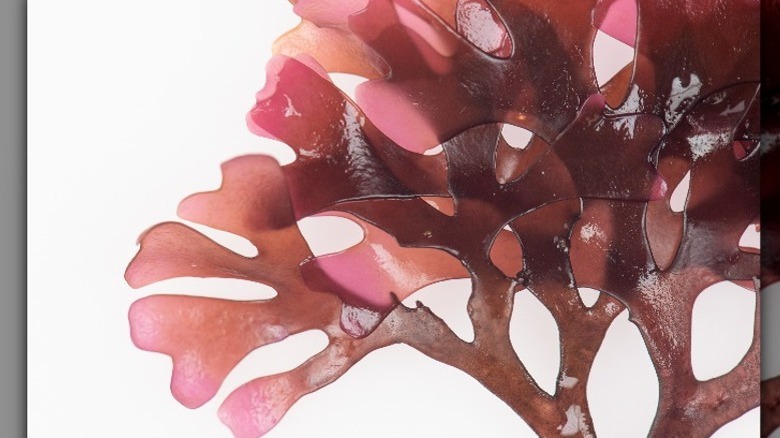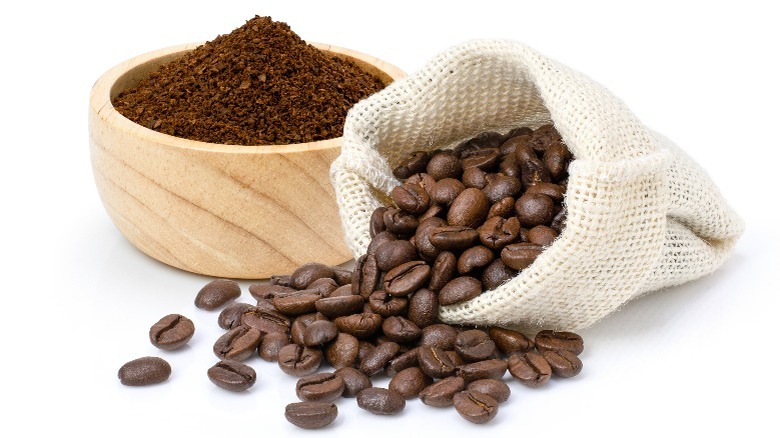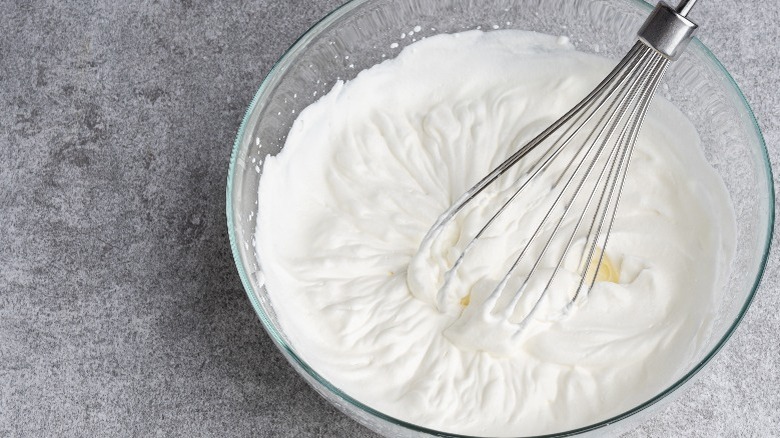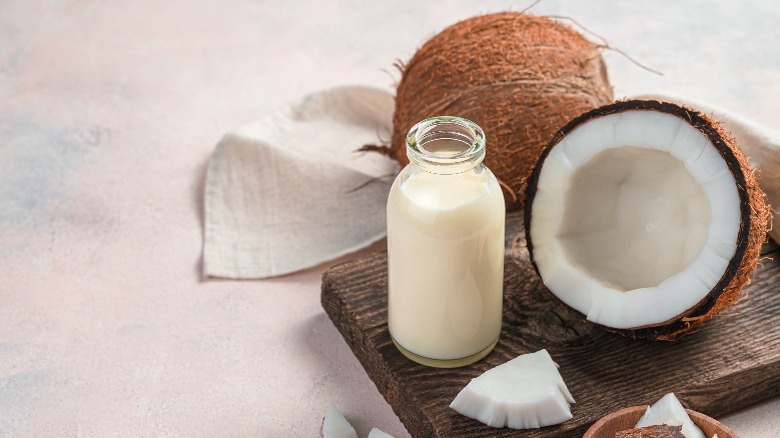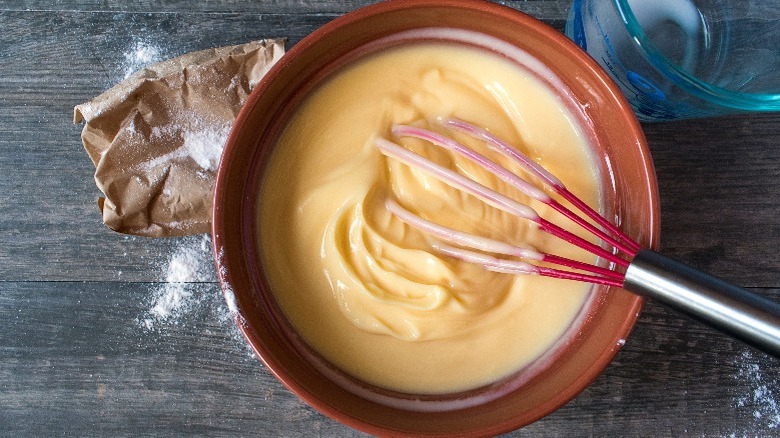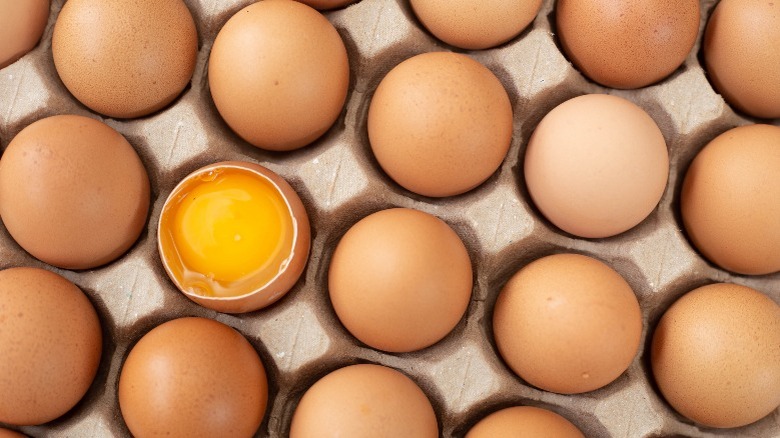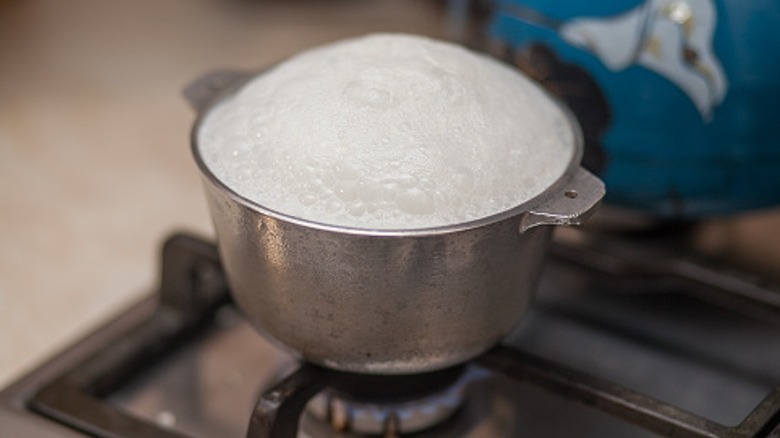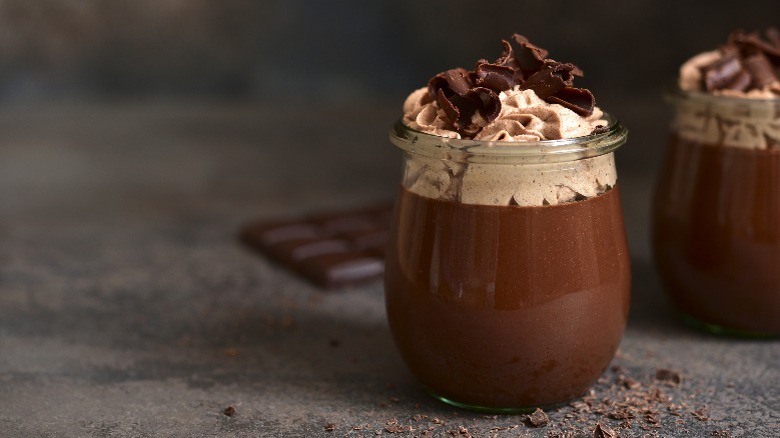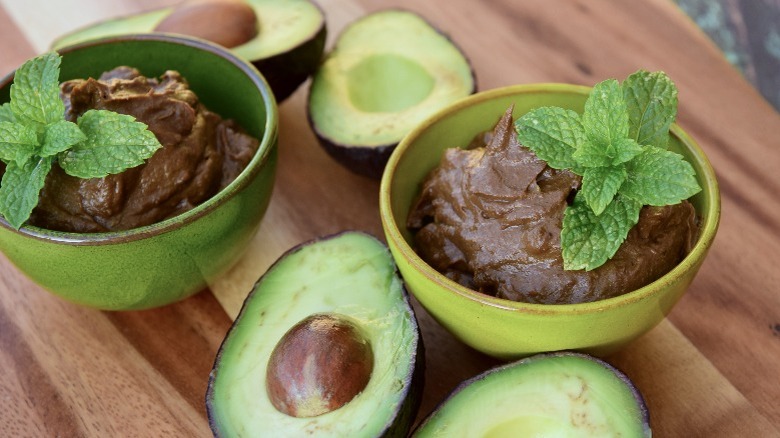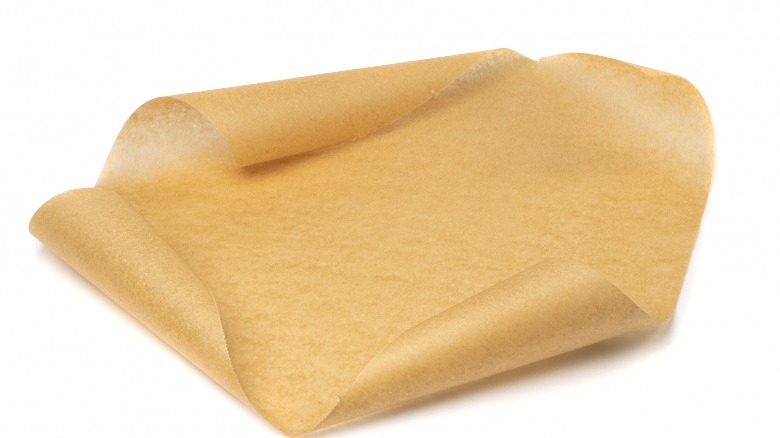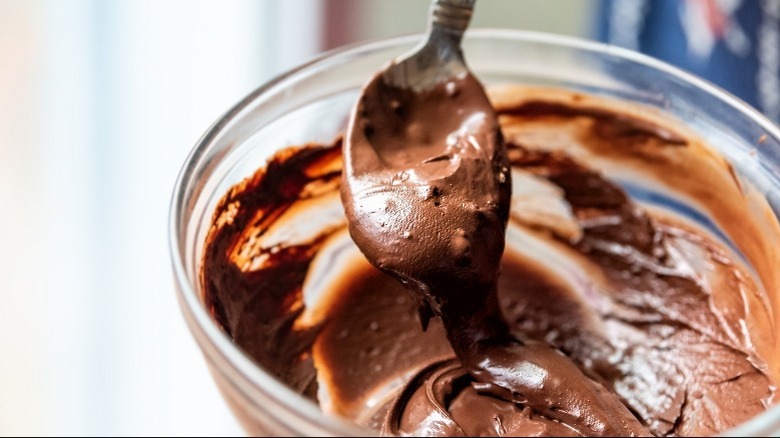15 Tips You Need For Making Homemade Pudding
Once a dish reserved for kids or the infirm, pudding is a treat we should all get back into. And it's not just the nostalgia that calls to us. The ease of preparation, the limited ingredients (pudding is easily made with stuff you likely have on hand), and the fact that few eaters can refuse it make us adore the stuff. Also, that smooth and creamy taste.
We've taken some liberties with the term pudding (vs. custard) in this article. Custard is always made with eggs, whereas pudding can be thickened with eggs or starch like flour or cornstarch. And don't even get us started on the British custom of calling nearly any dessert a pudding. While we adore the Brits and their custardy trifles, what we"re talking about here is something cooked on the stovetop that involves some kind of milk or cream, sweetened with sugar, thickened with yolks or starch, and flavored with chocolate, vanilla, banana, or butterscotch. Pudding is perfect, whether you're a fan of the skin or not.
Use cornstarch as an egg replacement for vegan pudding
If you're looking to make the transition to vegan cooking or if you have a food allergy, you'll be able to find substitutes for dairy easily enough. Eggs, on the other hand, are a little trickier for so many reasons. The high protein content is incredibly helpful in holding baked goods together, and that's pretty hard to replicate. In puddings and custards, eggs are a thickener, making your dish creamy and thick without chalkiness.
Cornstarch might be one of the best replacements for egg yolks in puddings, mostly because you likely already have it in your arsenal, and it's cost-effective since it doesn't take very much. The best way to incorporate it into your dessert is to mix it with water, making it into a slurry. This ensures that it's mostly dissolved before you add it, so you'll avoid any surprise, dry chunks in the finished dish. We think it's one of the best egg swaps that won't sacrifice texture in your puddings.
Make sure to cook long enough when using cornstarch
As we just mentioned, cornstarch is a pretty great way to thicken pudding without gluten or even much of a bother. Just make sure that you have actual cornstarch and not another corn-based product, like masa or corn flour. Cornstarch is inexpensive, lasts forever, and is really easy to find. It also works like a charm to thicken any other sauces or gravies.
But before you dump a pile of it into your runny pudd, let us give you some advice. Like any other starchy flour, cornstarch works best when made into a slurry before adding to the final product. This will help to eliminate any lumps by starting to dissolve the solids and getting things smooth. Next, never add cornstarch at the very end of the recipe unless you're going to continue cooking. Much like flour, cornstarch needs to be "cooked off" in order to get rid of the raw taste and to activate the gelatinization of starches; we heartily recommend the one-minute cooking rule here.
Thicken runny pudding with gelatin
What about fixing a runny pudding? Eggs or cornstarch will both help to thicken things up, but you do have other options. If vegan options aren't a concern for you, gelatin is a great way to fix a pudding that is a little too soupy for your liking. This also works really well if you're avoiding gluten and want to forego using flour as your thickener. Available in sheets or granules, gelatin isn't that hard to use, but you might find that it's a special purchase if you don't have a pantry full of specialized ingredients.
Don't get ahead of us and assume that adding gelatin means that your dessert will turn out like creamy chocolate Jell-O (although that does sound pretty great). Depending on the amount used, gelatin can give just enough soft hold to make your dessert spoon-worthy. Think stabilized whipped cream rather than those wiggly ring molds of the 50s. Follow Rose Beranbaum's gelatin tips to get the most out of this helpful ingredient, including always blooming it in cold water and always (always!) measuring.
Use Irish moss to thicken runny vegan pudding
Now, what if you've ended up with a runny pudding, but you're also vegan? Don't despair; there are still loads of options for you, too. Cornstarch or flour are always options but what about something with a richer history and even some old-school, traditional Irish street cred? Irish moss is actually a kind of seaweed that has been used for years, first as a way to get nourishment into the infirm and now as an alternative to animal gelatin. Known in the food industry as carrageenan, it works in the same way as gelatin when added to food.
Depending on where you live, Irish moss may be harder to come by, but it's also widely used in many coastal areas. Tasteless and colorless once dried and powdered, it is easy to use in anything that could use a little bit more body, including stocks, stews, or mousses. If you're not near the coast, you may have to try a health-food store for your supply of this ingredient, although it's also readily available on the internet.
Add more flavor to chocolate pudding with espresso powder
There are so many flavor combinations that work perfectly, amping each other up in unexpected ways without overpowering each other, like cinnamon and nutmeg or cherry and almond. For your next chocolate pudding, can we suggest adding just a hint of coffee for a truly gold-star taste? You don't even need to go overboard here; just a hint of coffee can bring out the best qualities of your chocolate flavor without turning your dessert into a full-on java explosion. Think of it like adding a pinch of salt to something sweet. It's undetectable as salt yet still rounds out the tastiness profile.
You have a few options when adding coffee to your puddings, so choose the one that works best in your situation. Add a teaspoon of instant coffee (or super fine-grind espresso powder) to your wet ingredients for a boost to the chocolatey flavor. If you're looking to go full mocha, two (or even three, if you love that buzz) teaspoons will make the coffee more discernable.
Swap out milk for heavy cream
If you've been relying on lower-fat dairy products in your favorite pudding recipes, we'd like to suggest you get your hands on something with a little more tasty fat. A heavier dairy ingredient, anything from 10% to 35%, will give you a substantial upgrade when it comes to creaminess.
If you go with half-and-half, you can easily swap it out for the same amount of milk called for in the recipe. This ingredient is made from milk and heavy cream (in half-and-half proportions, hence the name). However, if you have heavy cream (whipping cream), you have two options here. First, you can substitute a 50% cream/50% water mixture for the amount of milk used. Cutting it with water means that you'll still get the creamy texture you desire, but you won't end up with an ultra-dense finished product. Your other option is to whip the cream before adding it — this will give your dessert a lighter, mousse-like texture that's also pretty scrumptious.
Swap out milk for coconut or almond milk
While it might be pretty easy to replace dairy with other products from the same family, if you're looking for a dairy-free alternative, the balance might not be the same. This is mostly because of the amount of fat and protein in each and how your ingredients interact. However, many nut milks will need to be amped up to give you a creamier texture.
Almond milk, in particular, has a lot less fat than regular dairy, so you'll need to add something to give your pudding some oomph. The light-textured Sicilian almond milk pudding, biancomangiare, use cornstarch to help thicken while not adding a lot of heavy creaminess. If you want a creamier texture, you'll have to add fat in some form — like egg yolks or oil. On the other hand, coconut milk generally has more fat than cow's milk, so it will give you all the lushness you desire. Try full-fat coconut milk or even coconut cream to give you a dreamy finished product.
Always use a whisk
We get it — pudding has such a homey vibe that you might not want to do anything to wreck the idyllic ideal of shimmying into a vintage apron and using your oldest wooden spoon to June Cleaver that pudding into submission. Stop stirring your pudding because a wooden spoon will only get you so far in this scenario.
Instead, pull out a whisk and start whipping your ingredients into a perfectly smooth and fluffy pudding in no time. Using a whisk is the best option for a few reasons. To begin, it will get rid of any lumps (which is also why you should be whisking your gravy) much more easily than any spoon ever could. This is especially important if you've used any kind of powdered ingredients like flour, cornstarch, or coffee. Next, that whisk is going to aerate that pudding far better than a wooden spoon ever could, giving you a lighter and more mousse-like texture. Finally, it's just a more efficient way to incorporate ingredients homogeneously.
Keep your pudding from curdling by properly tempering your eggs
While homemade pudding is a pretty easy dessert to master, there are a few ways that you can fail. One of them is to try hurrying the process with too-hot ingredients. Even if you love pudding skin, we can guarantee that you won't be a fan of butterscotch pudding filled with blobs of scrambled eggs, right?
If you've been cooking for a while, you may already be familiar with the concept of tempering. Overcooking eggs (too fast or too hot) will lead you to lumpy chunks of eggs that, while being appreciated in fried rice or pad Thai, will only cause distress in a creamy dessert. Now, this is generally only a problem in a stovetop pudding. If you're making a baked pudding with a water bath, you won't have to worry about it, as the cooking method is rather gentle. On the stove, however, you'll have to proceed carefully. By slowly adding a portion of the mixture from the stovetop to your cracked and whisked eggs, you'll gently bring the temperature up enough that you'll end up with a smooth and cohesive pudding.
Take your time heating your milk
Another way to mess up that creamy delight again involves too much heat. Pudding is a pretty quick and easy dessert, sure. But go at it too hot, and you'll be sorry. Just like the eggs, heating your dairy ingredients too fast will just stymie your pudding production.
Milk, unlike other dairy alternatives, can curdle quickly if heated too high. Scalded milk is one thing but curdled is another (truly unappetizing) situation. It won't hurt you, but it will make your pudding pretty unappealing. You have a few options to deal with this, so don't fret. First, you can always temper that milk to gently bring it up to temp before adding it to the whole. If you've got everything in the pot already, just slowly bring the mixture up to temperature while stirring. Finally, keep in mind that dairy products with a higher fat content (heavy cream instead of 2% milk) can withstand more drastic temperature changes with less chance of curdling.
Remember to upgrade with add-ins
Sure, a big old bowlful of pudding is pretty delish. But what would make it even better? A ton of all your other favorite sweets, all crushed up and added in. Let your inner child go free and imagine what you could layer or swirl into your freshly made pudding. From cookie bits to candy to any kind of chocolate you have on hand, go nuts. Also ... try nuts.
Like all kinds of trends, pudding has had some time in the spotlight recently, specifically in an amazing trend called a pudding topping bar. Like other mix-in social media darlings such as hot chocolate, ice cream, or cupcakes, settings out a variety of toppings and mix-ins for your base and then going nuts (again with the nuts), mixing and swirling to your heart's content. If you're not in the mood to wash all those bowls after your squad has filled with marshmallows, gummy worms, or honey-roasted peanuts, skip the do-it-yourself step; just add whatever you like before dishing it out.
Use the right ingredients for rice pudding
So far, we've stuck to pretty basic puddings — sugar, milk, starch, and a little flavor. But what about that other beloved variety, rice pudding? Made in nearly the same way, subbing rice in for the powdered starch, rice pudding is another spoonable dessert that fills us with nostalgia.
Now, there are so many ways to make rice pudding using every type of rice that we can't even begin to cover them all here. However, we firmly believe that short-grain rice, like arborio, will make the best rice pudding that you've ever tasted. Looking for something a little more exotic? Give this Forbidden Rice pudding a try. With its deep purple-colored grains and nutty flavor, it makes for an absolute showstopper of a dessert. Unlike fried rice, you don't need to have a pile of last night's rice to indulge in this comfort food. Slowly cooking the rice with sweetened milk will give you a pudding with a nice chewy texture, although leftover rice can be a timesaver when you're craving dessert immediately.
Use avocado for a healthy upgrade to your puddings
Like guac? How about avocado toast? We have some good news for you if you say yes to either. That gorgeous green berry (yeah ... we were pretty surprised, too) is a perfect addition to anything that just needs a little creamy upgrade.
If you're looking for a way to add lushness without animal products, the healthier fat from this superfood might just be your answer. We even think that it will change your homemade pudding forever. So shed your preconceived ideas about the avocado being savory and start using it as it was intended — in a sumptuous, chocolatey dessert. Sure, you might equate them with savory dishes, but that might only be because that's what you're used to. Avocados have a buttery richness and umami quality that only enhances the recipes that they're added to, like pudding, for example. Much like overripe bananas, brown avocados are a perfect addition to all kinds of sweet treats, adding nutritional value to your favorite indulgences.
Avoid skin on top with parchment or wax paper
Show of hands — are you one of the few who actually like the chewy skin that forms on top of cooled homemade pudding? We know you're out there, so we respectfully acknowledge that it's your choice to skip this particular tip. For everyone else, here's a pretty easy way to keep your dessert decedent from top to bottom.
The skin forms as the pudding cools and steam escapes, drying out the surface layer. The simplest way to avoid this, aside from indulging in an entire bowl of still-warm pudding, is to press something impervious against the surface. Parchment paper, wax, paper, aluminum foil, or plastic wrap are all feasible. The biggest problem with this method is that you'll end up licking the top layer of pudding off whatever you use, so choose whichever one you like the taste of. Another reason that you might want to cover your pudding, whether you're a fan of the skin or not, is to avoid your creamy banana delight from absorbing the smell of last night's fish tacos.
Let it set without stirring
Now that you've got a handle on all your substitutions and techniques, you can let that lush bowlful cool down until it's time to dive in. And here's our final tip — leave it alone. Pop it into the fridge and just give it some time to thicken up, becoming the most delicious version of itself. Hands off, we mean it!
As your pudding cools, it needs time to set. If you're continuously disturbing it by stirring it, you may actually ruin it. By getting in there with your whisk or spoon, you're breaking up the ingredients that you just worked so hard to incorporate. What this means is that you'll likely end up with a chunky pudding or, even worse, a watery one. If you've made the custard properly, there's no reason to continue stirring as it cools, anyway. If the ingredients are whisked well enough to blend thoroughly, they don't need any more help. You'll also run the risk of losing any of the lightness you managed to whisk in there, as well.
